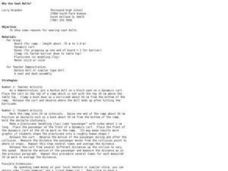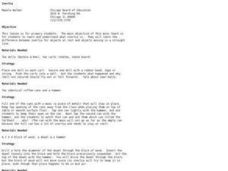Curated OER
The Barbie Bungee Drop
What do math, bungee jumping, and Barbie® have in common? Young adventure seekers use rubber bands as bungee cords to predict a thrilling, but safe, jump for their doll. First, test jumps are conducted with a few rubber bands. Then more...
Curated OER
How Big is Barbie?
Students measure various dimensions of a male and a female dolls body and scale them proportionally to average human measurements. They calculate the appropriate scale factor (magnitude) to enlarge their doll and apply that scale factor...
Curated OER
It's All About Scale
Sixth graders investigate scale models of toys. In this scale models of toys lesson, 6th graders bring in toys from home to measure. Students discuss scale and what scale is used with their toys. Students determine the...
Curated OER
Why Use Seat Belts?
Learners explore reasons why using a seat belt is a safe choice while riding in a car. In this physics/safety lesson, students set up and observe a doll with and without a seat belt moving down a ramp in a dynamics cart. Collision...
Curated OER
Bungee Barbie
Pupils discover the relationship between force and the amount of time over which the force is applied. They discover the meaning of impulse and it equals the change of momentum. Students connect things to a computer to test their results.
Curated OER
Electricity
Students explore electricity. After watching a PowerPoint presentation, students discuss the composition of electricity and how it is made. They participate in discovery activities by rotation through four activity stations set up on the...
Curated OER
How Can We See Inertia?
Students conduct 8 experiments to gain an understanding of inertia. Students use a variety of materials to conduct these experiments. Students learn the difference between objects at rest and objects moving in a straight line.








